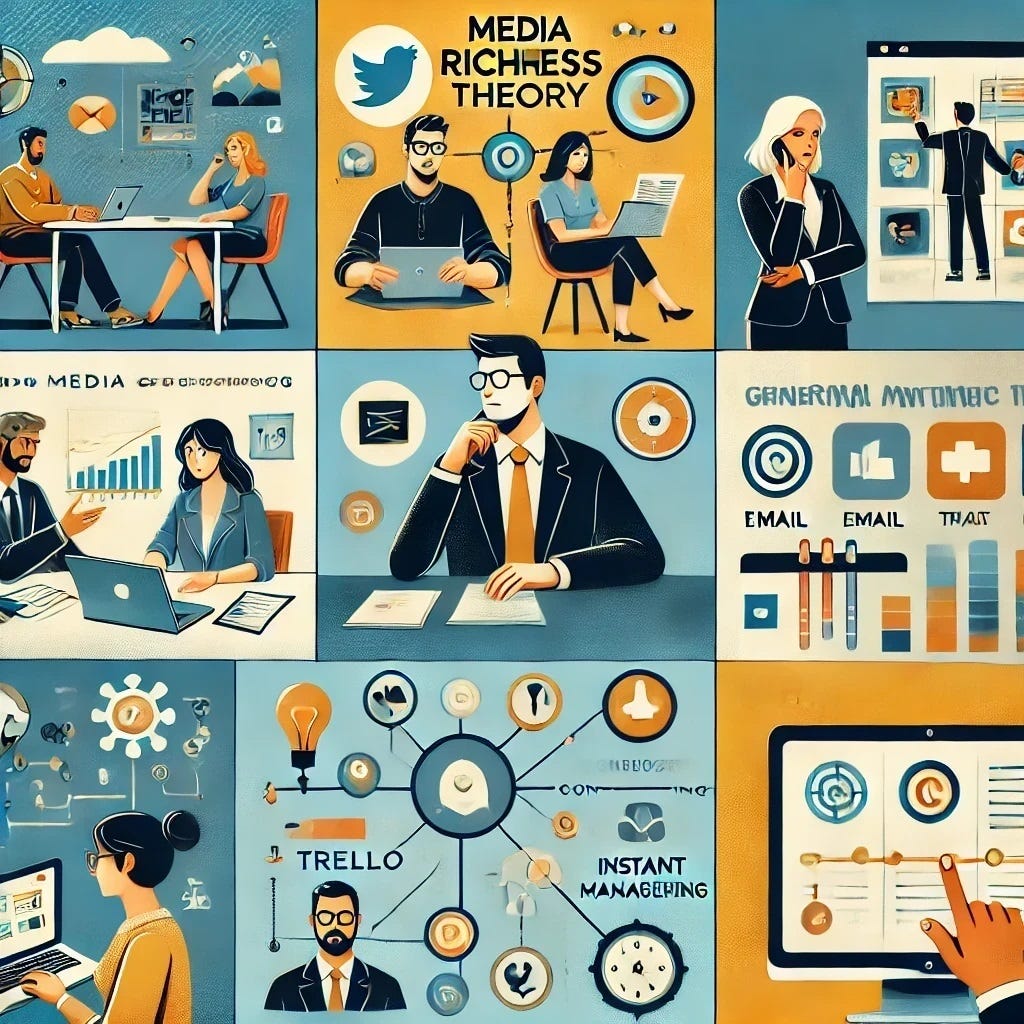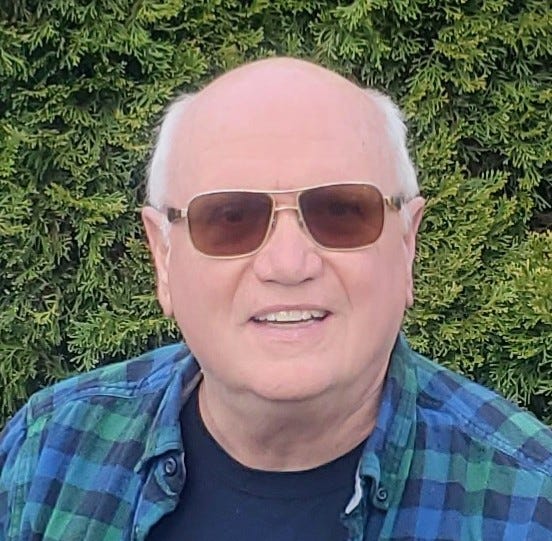Enhancing Remote Team Communication with Media Richness Theory
Plan in advance to navigate the mental filters that affect understanding
Welcome to the Gazebo! Grab a cup and join me for some tips to help you succeed at the intersection of management, communication, and technology.
This Week’s Summary:
Comparing a typical remote worker morning routine to the commuter’s
Critical role of communication technology for remote work environments
Ways in which managers and team member communicate (or not)
Core manager and team member responsibilities
Ways that media richness theory can guide team communication
Imagine this: It’s Monday morning, and you just finished an arduous 30-second commute from the kitchen to your office after stopping off at the microwave for a breakfast burrito and a cup of coffee. An accidental run-in with your puppy almost made you late! 😊 That’s right. You are a remote worker, and this is your morning reality instead of sitting in slow-moving traffic after hitting a fast-food drive-through.
As I have written before, there is a lot to like about this lifestyle, and managers should not be surprised when they meet with resistance when they force folks to give it up.1 To me, a mandatory return-to-office is an unnecessary point of friction because many jobs can be done as a blend of in-office and remote, if communication is structured properly.
Image created by Ed Paulson 2024 using ChatGPT.
This article continues my discussion from last time about ways in which media richness theory and the Paulson Media Matching Method can be used as a tool for turning the remote work/in-office decision into an operational/quality of life discussion instead of what might be viewed as a management power play. 2
As a remote worker, your team may be spread across different time zones, or perhaps continents, and your projects likely require some level of seamless (hopefully) collaboration. If you are the team manager, a primary function is to ensure that your team delivers on time, on budget, and with quality. If you are a team member, your job is to successfully complete the tasks related to your specific job, which not only supports the overall organization but also ensures that your team as a unit excels in its performance.
Our Brains Interfere with Accurate Message Understanding
A major challenge to clear communication under the best of circumstances is that we all have prior experiences and expectations that create “communication filters” (such as pre-existing biases) that interfere with our ability to accurately understand what another has communicated to us. We may THINK that we understood what another has communicated but there is a reasonable chance that what we understood was NOT what they intended.
When we start to use intervening technologies such as email, text, IM, phone, or video we inject another set of communication filters that further affect information transfer and feedback availability. This means that we and our message receivers may never be aware that our messages were misunderstood and as a result we will be taking future actions based on flawed beliefs and misunderstandings.
This is where media richness theory comes into the picture because it can highlight communication misunderstandings when they happen.
Feedback is Needed to Ensure Proper Understanding
Media richness theory is a conceptual framework that categorizes communication methods into five richness levels as determined by their ability to convey information and offer feedback. At the leanest level, written reports offer no interaction, while face-to-face communication stands at the richest level, providing immediate and nuanced exchanges. Between these extremes are personal memos, emails, phone calls, and video conferencing. Each level offers varying degrees of feedback, immediacy, and depth.3
Image Copyright © 2023 by Ed Paulson. All rights reserved.
It is a powerful communication tool in part because it uses feedback as a critical communication component that must ALWAYS be considered when planning a communication. Without feedback to confirm that your messages were properly understood, you will be operating on the assumption that you were understood as intended — a risky proposition that often leads to later problems. Using a structured communication method helps to ensure that messages are on target and understood properly, which helps everyone stay on the same page.
Better Communication Means Better Performance
Team managers and members have different roles and responsibilities, and as such they will use communication differently to achieve their outcomes.
Arguably, a manager’s most fundamental responsibility is to manage their team’s activities such that the overall team objectives are met on time, on budget, and to specification. The ways in which a manager accomplishes these goals will be a combination of management science, manager personality traits, organizational circumstances, and inter-personal dynamics, and no cookbook approach can address all possible management situations.
From a communication perspective, at its most basic level, managers want to know that their team is moving in the desired direction with the right level of speed to achieve objectives within the required timeframe, specifications, and budget. They want to know if the team is falling behind or is off course early enough to correct the situation before it becomes a major performance issue. From the manager’s perspective, clear expectations, early intervention, and supportive feedback are essential to keeping the team on track to meeting its goals. A manager MUST have accurate and timely feedback to achieve these goals.
Team members want to clearly understand their manager’s expectations, the specific objectives they should be focused on, and when/how to reach out for assistance if they feel they might be getting in over their heads. They must have access to accurate and timely feedback to keep themselves on track. From the employee’s viewpoint, clarity, safety, and mutual understanding are critical.
Selecting the proper media richness level for communicating the information needed to establish a core level of team-wide understanding is critical to ensuring that a team gets started on a solid footing. Media richness theory offers basic guidelines for the best ways to communicate information, whether by email, telephone, video conference, or even in-person meetings.
Considering the media richness theory concepts when communicating is a great practice to adopt, but you will soon find that they don’t apply well to many situations. This is because the personal, educational, and professional history of both senders and receivers of a communication, such as the manager and team members, will affect the perceived level of media richness beyond the simple technology divisions offered in the base theory. This is where my Paulson Media Matching Method comes to play.4
For example, a particular message might appear complicated to a newer employee where that same message might appear routine to those who have much work experience in the company, industry and with each other. As a general rule of thumb, if the message appears complicated such as to the novice worker, then richer media (Level 4 or 5) is recommended. If it appears simple, as it would to the experienced worker, then leaner media (such as Levels 1 to 3) might suffice.
Summary
There is little question that when organizations prioritize proactive5 communication design and implementation, instead of treating communication as a reactive afterthought when problems occur, they will create a work environment where managers and employees more effectively collaborate, innovate, and succeed together.
By intentionally designing their communication processes and framework, managers and leaders can ensure that both their in-office and remote teams not only meet their goals but also maintain a sense of connection and shared purpose.
High performing teams don’t just happen by accident. They develop from a conscious effort to promote synergy, a sense of direction, and shared responsibility for performance. Communication is the catalyst that makes this happen.
Next time we will take a detailed look at some typical team communication processes and see how they would be mapped against the media richness and media matching frameworks.
Thank you for stopping by, as always. Peace.
P.S. It would be my pleasure to work with you applying these powerful concepts to your particular organization. Drop me an email at author@edpaulson.com or call me at 630.960.3299 USA to set up a time for us to talk in detail about your needs.
If you liked what you read, then click the Subscribe Now button to automatically receive the next edition. I’d love for you to join us! It’s free, by the way.
Don’t miss out on something helpful and/or thought provoking simply because you forgot to visit my site. Automatically receive my management communication success newsletter every Monday to start your week off on a solid note! Your information will never be shared and it will only be used for us to communicate with each other.
BECOME MORE SUCCESSFUL THROUGH BETTER COMMUNICATION
LEARN A LIFETIME OF COMMUNICATION SECRETS BY READING ED’S “GETTING THROUGH” BOOK
Listen to Ed Paulson explain his latest book “Getting Through.”
(Short 3 minute video)
“Getting Through: A Systematic Approach To Being Understood” (ISBN: 9798987950807) is available from Amazon, Barnes and Noble, and other retailers. It is only 130 pages long and can be read in just a few hours. Those few hours will change the way you communicate forever!
Getting Through: A Systematic Approach To Being Understood (ISBN: 9798987950807)
Copyright © 2024 by Ed Paulson. All Rights Reserved.
See my February 19, 2024 and November 25, 2024 posts for more insights into the benefits of working remotely for both the company and its employees.
If you would like to know more about this powerful topic, you should pick up my “Getting Through” book.
You can get a more detailed discussion of media richness theory by looking at my November 25, 2024 post.
You can view the chart that is at the heart of my Paulson Media Matching method by clicking this link to my website. Paulson Media Matching Method. It adds many important details to the simple media richness levels chart shown.
Proactive communication design happens when communication is considered as a key management component from the beginning, enabling the right people to have needed access to the right information or people, at the right time, to achieve their intended objectives.






